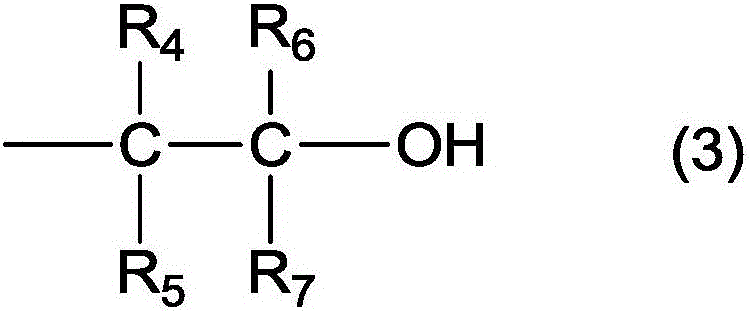Liquid crystal aligning agent, and liquid crystal display element using same
A technology of liquid crystal aligning agent and liquid crystal aligning film, which is applied in coatings, instruments, optics, etc. It can solve the problems of insufficient substrate bonding and no covalent bond formation, so as to improve adhesion without reducing liquid crystal orientation Effect
- Summary
- Abstract
- Description
- Claims
- Application Information
AI Technical Summary
Problems solved by technology
Method used
Image
Examples
Embodiment
[0202] Examples are given below to further describe the present invention in detail. However, the present invention is not limitedly interpreted by these Examples. The abbreviations of the compounds used are shown below.
[0203] NMP: N-methyl-2-pyrrolidone GBL: γ-butyrolactone
[0204] BCS: Butyl Cellosolve IPA: 2-Propanol
[0205] NEP: N-ethyl-2-pyrrolidone PB: Propylene glycol monobutyl ether
[0206] DA-2: a compound represented by the following formula (DA-2)
[0207] DA-3: a compound represented by the following formula (DA-3)
[0208] DA-4: a compound represented by the following formula (DA-4)
[0209] DA-5: p-phenylenediamine
[0210] DA-6: 3,5-Diaminobenzoic acid
[0211] DA-7: 4,4’-Diaminodiphenylmethane
[0212] DA-8: 4,4’-Diaminodiphenylamine
[0213] DA-9: 1,3-bis(4-aminophenoxy)propane
[0214] DA-10: 1,5-bis(4-aminophenoxy)pentane
[0215] DA-11: a compound represented by the following formula (DA-11)
[0216] DA-12: a compound represented by the fo...
Synthetic example 1
[0262] Measure 2.92 g (27.0 mmol) of diamine DA-5 and 20.71 g (3.0 mmol) of diamine DA-20.71 g (3.0 mmol) into a 100 mL four-necked flask equipped with a stirring device and a nitrogen gas inlet tube, add 81.76 g of NMP, and stir while feeding nitrogen gas to make It dissolves. While stirring this diamine solution, carboxylic acid dianhydride DC-16.46 g (28.8 mmol) was added, and further, NMP was added so that the solid content concentration became 10% by mass, and stirred at room temperature for 4 hours to obtain a polyamic acid solution (PAA-1). The viscosity of this polyamic acid solution at a temperature of 25° C. was 230 mPa·s. In addition, the molecular weight of this polyamic acid was Mn=11,131, Mw=30,009.
Synthetic example 2
[0264] Diamine DA-52.27g (21.0mmol) and diamine DA-42.69g (9.0mmol) were weighed into a 100mL four-neck flask equipped with a stirring device and a nitrogen gas inlet tube, NMP61.87g was added, and nitrogen gas was sent while stirring to make It dissolves. While stirring this diamine solution, carboxylic acid dianhydride DC-25.59 g (28.5 mmol) was added, and further, NMP was added so that the solid content concentration became 12 mass %, and it stirred at room temperature for 4 hours, thereby obtaining a polyamic acid solution (PAA-2) solution. The viscosity of the polyamic acid solution at a temperature of 25° C. was 410 mPa·s. In addition, the molecular weight of this polyamic acid was Mn=9,042, Mw=19,958.
PUM
| Property | Measurement | Unit |
|---|---|---|
| thickness | aaaaa | aaaaa |
| viscosity | aaaaa | aaaaa |
| viscosity | aaaaa | aaaaa |
Abstract
Description
Claims
Application Information
 Login to View More
Login to View More - R&D
- Intellectual Property
- Life Sciences
- Materials
- Tech Scout
- Unparalleled Data Quality
- Higher Quality Content
- 60% Fewer Hallucinations
Browse by: Latest US Patents, China's latest patents, Technical Efficacy Thesaurus, Application Domain, Technology Topic, Popular Technical Reports.
© 2025 PatSnap. All rights reserved.Legal|Privacy policy|Modern Slavery Act Transparency Statement|Sitemap|About US| Contact US: help@patsnap.com



